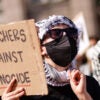No one knows for certain the number of organized opposition groups in Syria and opposition militia forces fighting in the Syrian civil war. These irregular guerrilla forces fighting primarily against the Syrian army range from secular groups to Salafi Islamist militants.
The Islamist factions are reportedly split between groups that have a Syrian national agenda and those that have a global agenda, but they cooperate with one another. Serious tensions exist within the overall opposition; al-Qaeda-linked groups are simultaneously fighting the Syrian army and the moderate Syrian opposition forces. The al-Qaeda-linked groups remain the best financed, best armed, best organized, and most seasoned fighters.
The Daily Signal depends on the support of readers like you. Donate now
The civil war in Syria is much like the civil war in Afghanistan after the Soviet withdrawal in 1989. After the U.S. turned its back on the Afghans, Pakistan and Saudi Arabia filled the vacuum by backing the Taliban militants who turned Afghanistan into a base for al-Qaeda. If Washington continues to shun the Syrian opposition, then the eventual fall of the Bashar al-Assad regime is likely to result in a Talibanized Syria.
While the moderate opposition continues to fight against Assad, it has failed to gain strategic ground against Syrian armed forces and militias. Meanwhile, al-Qaeda-linked groups such as Jabhat al-Nusra and al-Qaeda in Iraq and Syria have made progress in this same fight.
The Assad regime has also been unabashedly supported by Iran, a state sponsor of terrorism, and the Lebanese terrorist group Hezbollah.
It’s clear the Syrian civil war is not black and white. As Heritage expert Jim Phillips has repeatedly emphasized, this is a Hobbesian conflict where ultimately it’s everyone against everyone.
There’s little disagreement that Assad must go, but without a managed resolution, Syria could go from a really bad sub-state conflict to an all-out regional war.
In the absence of strong U.S. leadership and support over the past two-and-a-half years of the Syrian civil war, there has been a volatile global convergence of al-Qaeda-linked fighters amongst the Syrian opposition. Syrian rebel factions now run the risk of being overrun by al-Qaeda priorities instead of their own democratic and secular aims.
As long as al-Qaeda continues to draw and unify fighters from Chechnya, Pakistan, Egypt, Tunisia, Libya, Iraq, and Western countries, the conflict will continue to create greater personal connections among extremist groups from different regions and develop hardened fighters that can take their battle experiences elsewhere in the world to inflict terror.
Al-Qaeda has repeatedly recognized the usefulness of instability in Syria and its great potential for an al-Qaeda stronghold in the heart of the Middle East. This scenario would cut at the heart of U.S. national security interests and should be avoided at all costs.































